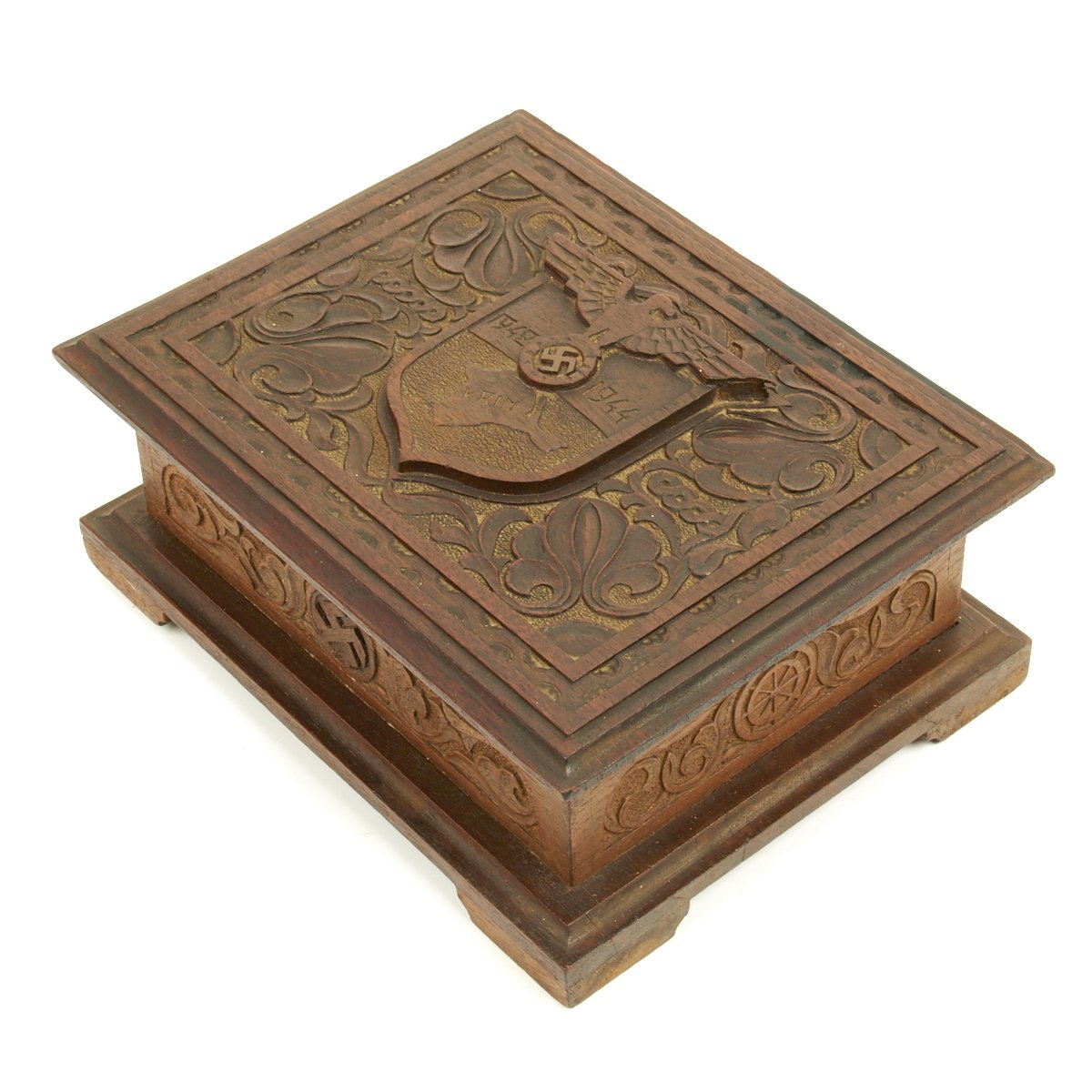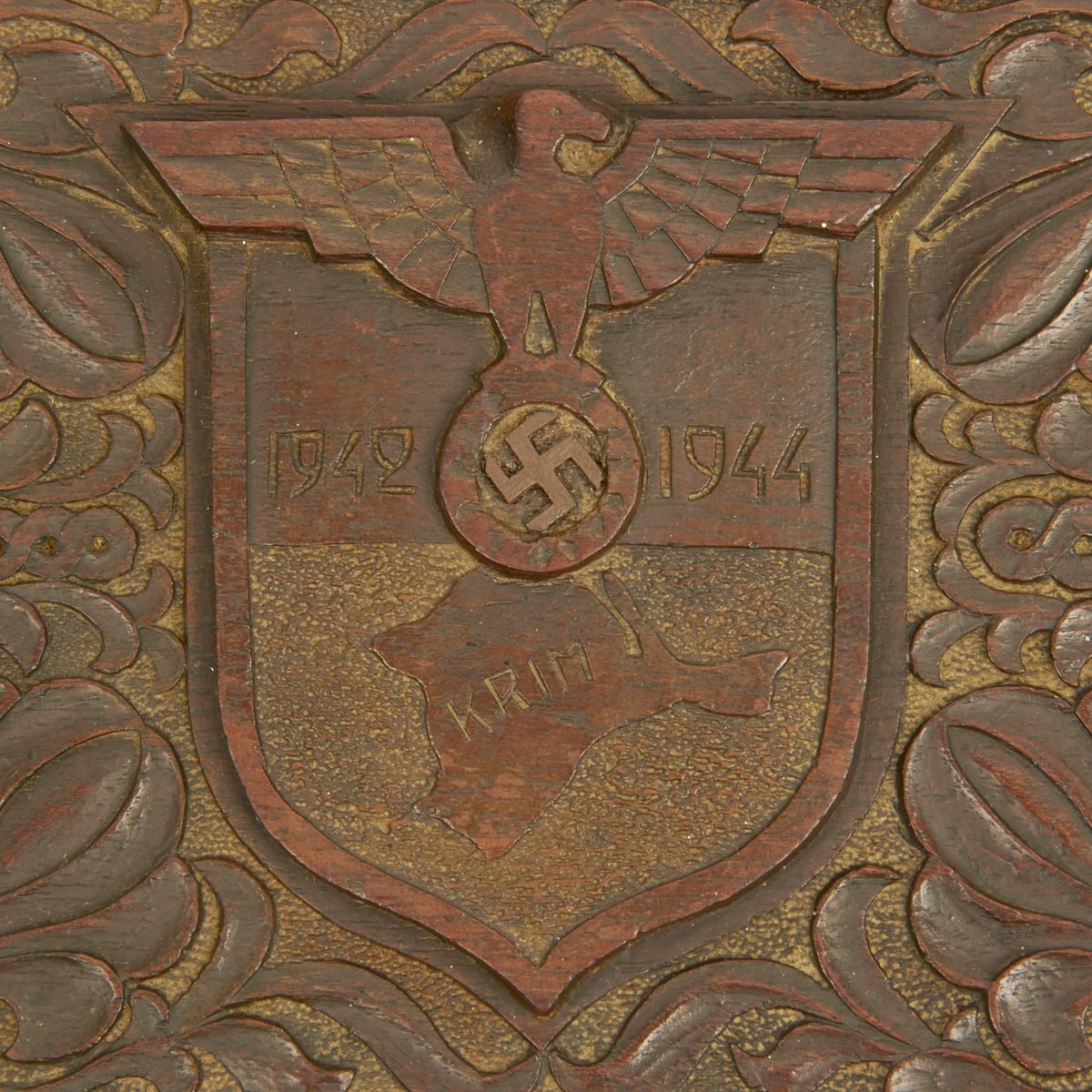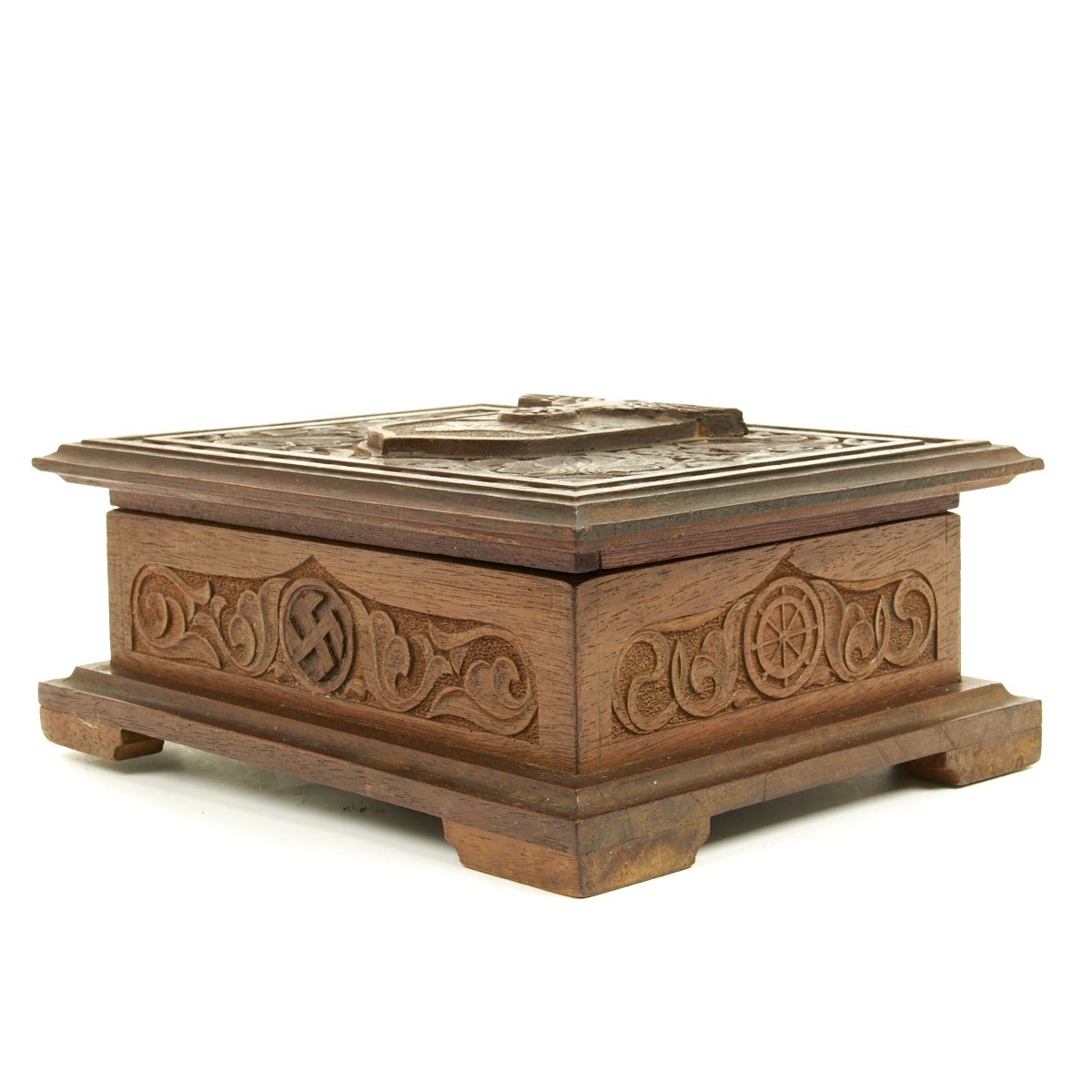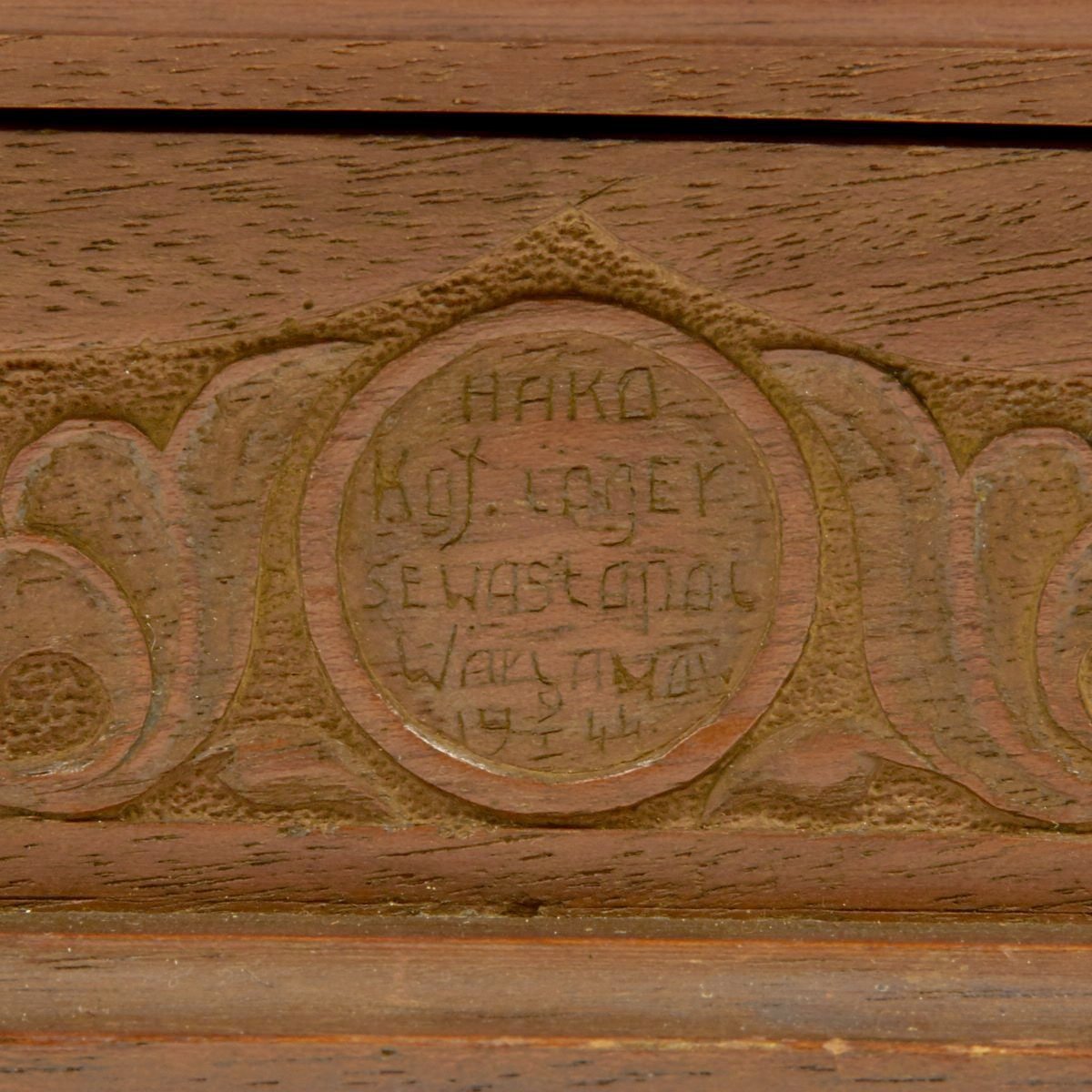Original German WWII Crimean Campaign Krim Shield Custom Wood Cigar Box – Named Original Items
$ 595,00 $ 178,50
Original Items: Only One Available. This is a fantastic handmade custom wartime wood cigar box that featured the KRIM shield with Swas on top and the dates 1942 – 1944. The box measures 9″ wide x 7″ deep x 3″ high. On the front side is another swas but on the reverse side is inscribed in the central medallion area what appears to read:
Workmanship of the box is excellent and it is offered in wonderful condition.
The Crimea Campaign was an eight-month-long campaign by Axis forces to conquer the Crimea peninsula, and was the scene of some of the bloodiest battles on the Eastern Front during World War II. The German, Romanian, and defending Soviet troops suffered heavy casualties as the Axis forces tried to advance through the Isthmus of Perekop linking the Crimean peninsula to the mainland at Perekop, from summer of 1941 through to the first half of 1942.
From 26 September 1941 the German 11th Army and troops from the Romanian Third Army and Fourth Army were involved in the fighting, opposed by the Red Army’s 51st Army and elements of the Black Sea Fleet. After the campaign, the peninsula was occupied by Army Group A with the 17th Army as its major subordinate formation.
Once the Axis (German and Romanian troops) broke through, they occupied most of Crimea, with the exception of the city of Sevastopol, which was given the title of Hero City for its resistance, and Kerch, which was recaptured by the Soviets during an amphibious operation near the end of 1941 and then taken once again by the Germans during Operation Bustard Hunt on 8 May. The Siege of Sevastopol lasted 250 days from 30 October 1941 until 4 July 1942, when the Axis finally captured the city.
In the early hours of 6 November, the Romanian submarine Delfinul torpedoed and sank the Soviet 1,975-ton cargo ship Uralets four miles South of Yalta. The submarine was subsequently attacked by Soviet forces but she followed a route along the Turkish coast and managed to evade up to 80 depth charges, before safely arriving in the port of Constanța on 7 November.
Sevastapol, the main object of the campaign, was surrounded by German forces and assaulted on 30 October 1941. German troops were repulsed by a Soviet counterattack. Later, many troops who had been evacuated from Odessa contributed to the defence of Sevastopol. The Germans then began an encirclement of the city. Other attacks on 11 November and 30 November, in the eastern and southern sections of the city, failed. German forces were then reinforced by several artillery regiments, one of which included the railway gun Schwerer Gustav. Another attack on 17 December was repulsed at the last moment with the help of reinforcements and Soviet troops landed on the Kerch peninsula the day after Christmas, to relieve Sevastopol. The Soviet forces remained on the peninsula until a 9 April German counterattack. They held on for another month before being eliminated on 18 May. With the distraction removed, German forces renewed their assault on Sevastopol, penetrating the inner defensive lines on 29 June. Soviet commanders had been flown out or evacuated by submarine towards the end of the siege and the city surrendered on 4 July 1942, although some Soviet troops held out in caves outside of the city until 9 July.
In 1944, the Crimea was recaptured by troops of the 4th Ukrainian Front during the Crimean Offensive (8 April 1944 – 12 May 1944) and its three sub-operations:
Kerch–Eltigen Operation (31 October 1943 – 11 December 1943)
Perekop–Sevastopol Offensive Operation (8 April 1944 – 12 May 1944)
Kerch–Sevastopol Offensive Operation (11 April 1944 – 12 May 1944)
Fast Shipping with Professional Packaging
Thanks to our longstanding association with UPS FedEx DHL, and other major international carriers, we are able to provide a range of shipping options. Our warehouse staff is expertly trained and will wrap your products according to our exact and precise specifications. Prior to shipping, your goods will be thoroughly examined and securely secured. We ship to thousands clients each day across multiple countries. This shows how we're dedicated to be the largest retailer on the internet. Warehouses and distribution centres can be located throughout Europe as well as the USA.
Note: Orders with more than one item will be assigned a processing date depending on the item.
Before shipping before shipping, we'll conduct a thorough inspection of the items you have ordered. Today, the majority of orders will be delivered within 48 hours. The delivery time will be between 3-7 days.
Returns
The stock is dynamic and we cannot completely manage it because multiple stakeholders are involved, including our factory and warehouse. So the actual stock may alter at any time. It's possible that you may not receive your order once the order has been made.
Our policy is valid for a period of 30 days. If you don't receive the product within 30 days, we are not able to issue a refund or an exchange.
You can only return an item if it is unused and in the same state as the day you received it. You must have the item in its original packaging.
Related products
Uncategorized
Uncategorized
Uncategorized
Uncategorized
Uncategorized
Uncategorized
Uncategorized
Uncategorized
Uncategorized
Australian WWII Owen MK1 Machine Carbine SMG Custom Fabricated Replica with Sling Original Items
Uncategorized
Armored Burgonet Helmet & Polearm from Scottish Castle Leith Hall Circa 1700 Original Items
Uncategorized
Armoured Fighting Vehicles of the World: AFVs of World War One (Hardcover Book) New Made Items
Uncategorized
Uncategorized
Uncategorized
Uncategorized
Uncategorized
Uncategorized
Band of Brothers ORIGINAL GERMAN WWII Le. F.H. 18 10.5cm ARTILLERY PIECE Original Items












































































